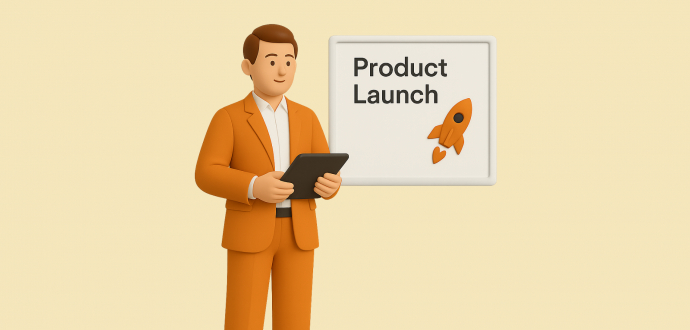10 Critical Items to Include in Your Product Launch Checklist

Believing your product will sell itself just because it’s great is a classic case of wishful thinking. Marketing knows thousands of examples when the best products remain unclaimed by the customers, collecting dust on the shelves, or never really leaving a warehouse.
Why is that? Their makers and marketers neglected the basic ingredient of every successful sales campaign — a solid go-to-market strategy. It’s about how you present (or position, speaking marketing language) your product to the market.
A good go-to-market strategy consists of many things, and doing it for the first time can be overwhelming. That’s why we’ve prepared this concise yet all-encompassing product launch checklist, which includes the 10 critical items to include in your strategy.
Don’t guess your way through launch — start with these 10 proven essentials.
What is a product launch checklist, and why do you need one?
A product launch checklist is basically nothing complex and technical. On the contrary, it’s a simplified version of a product launch template, where instead of filling in a predefined document in a fixed format, you get a loose list of the essential items to consider when preparing to launch a product.
Did you know? 95% of all new products fail, and only 40% of products developed survive on the market. This staggering failure and short-lived product life underpin the importance of a thorough and responsible product quality assurance.
Launching is stressful enough without guesswork. A product rollout checklist removes the mystery, showing exactly what needs to happen — and when. Paired with a go to market checklist for channel strategy, it ensures your product or service release lands in front of the right eyes, at the right moment.
Because everything’s spelled out, you avoid duplicate work and forgotten tasks. Each ticked line frees mental space for creative ideas that make the launch memorable rather than merely functional.
This is what a solid product launch list does:
- Provides a single, shareable roadmap to follow for everyone in the team.
- Highlights resource gaps, including financial and people’s capabilities.
- Reduces stress by clarifying priorities and ensuring quality.
- Ensures optimal resource usage by allocating responsibilities.
- Provides data for post-launch reflection & improvements.
In your list, use clear language and simple graphics (only if necessary, or when they provide additional info). Everyone on your team should have a clear understanding of your ideas, even at first glance.
It helps to think of the product rollout checklist as a friendly navigator. It keeps the launch crew on the same page, nudging everyone to handle tasks in the right order: messaging first, logistics second, celebration last.
1. Market and competitor analysis
All product launch checklists have one thing in common — they all start with a market, business, and competitor analysis. Think of this step as ground zero, the foundation of your go-to-market strategy.
Without a thorough understanding of who your competitors are, what the market is like today, and how your business (and product) characteristics fit into this picture, you cannot position your product for a successful launch.
Source: Bplans
Data alone can’t guarantee a win, but guessing almost guarantees a loss. Start your homework by charting direct rivals, adjacent players, and wildcard entrants who could jump into your lane.
Then shift to qualitative insight: interview early adopters and lost leads alike. Their stories reveal reasons deals close, or crumble, beyond price tags.
At minimum, this is what you should do:
- Capture unmet needs that no one addresses.
- Monitor and rank messaging tones that resonate.
- Identify the channels customers actually hang out on.
- List tech integrations that the modern buyers demand.
- Observe complaints about onboarding friction.
These proven truths fit neatly into a product launch strategy template, turning the fog of opinions into a clear product rollout checklist. By the time your product launch plan is ready, you’ll speak the market’s language and dodge errors rivals have already made.
Keep your market updates cyclical. Competitors rebrand, consumers shift priorities, and what wows last year might bore today. That’s the crazy reality and turbulence of the modern-day market.
A living analysis process will secure long-term relevance and protect your every future launch from painful missteps.
2. Unique value proposition and messaging framework
The UVP defines why your product stands out to buyers. One brand can have multiple products, each with its own UVP. It’s not something that is self-evident and lying on the surface; rather, each UVP requires a thorough analysis and brainstorming on your end.
Think of your UVP as the hook that turns passing interest into a double-take. It should answer one simple question customers always have in mind: “Why should I care?” If the answer isn’t crystal clear, you risk blending into the background noise.
Draft a first version, then pressure-test it with real people — friends, pilot users, even your most candid coworker. Their puzzled looks or follow-up questions show you exactly where the wording still needs work. From there, refine until your proposition feels and looks great, and a twelve-year-old could repeat it back.
Prepare to do the following:
- Survey three ideal buyers (via phone calls or a quick online survey).
- Map their top pain points.
- Compare your UVP to rival promises.
- Ensure to link the benefit to a tangible outcome.
- Trim every extra word (only the essence, no “water”).
Drop the final line into your product launch plan template so everyone, from design to customer support, speaks the same language. A shared statement ensures your product launch plan rolls out with one consistent story instead of a jumble of taglines.
Finally, bake the UVP into visuals, demos, and sales scripts. Repetition isn’t vanity; it’s how memory works. When launch day arrives, each touchpoint should echo the same promise, making it nearly impossible for customers to forget why your solution matters.
3. Content calendar and launch assets
Once the strategic and high-level product launch framework is ready, it’s time to deal with the more down-to-earth items, such as the launch assets and content calendar.
Source: Freepik
The main question they both answer is “Who says what, and when do they say it?” Your content plan answers that in plain language, turning the product launch template into a day-by-day plan. Cross-referencing it with the go to market checklist ensures every piece of content supports a concrete launch objective.
Get yourself ready to prepare and deploy these must-have assets:
- A branded (aligned with UVP) animation for your stories and reels, building anticipation among the target audience.
- A product demo video that shows real-world use cases instead of tasteless feature slides. User-generated content will play out even better for this purpose.
- Partner-influencer posts, scheduled to drop within hours of the official product release.
- A FAQ landing page that addresses common concerns of your audience and links to live chat for further questions.
- Follow-up emails sharing early customer testimonials (prepare templates for ones in advance) to reinforce social proof and drive loyalty up.
Map each asset to a color-coded timeline so stakeholders spot gaps at a glance. Then sync the calendar with the broader product rollout checklist to avoid resource clashes (no designer can finish six graphics in one day).
Remember to build in buffer time. Edits happen, approvals lag, and life surprises everyone. Having a realistic calendar keeps morale up and content quality high.
By launch week, you should spend more time engaging with eager customers and less time hunting for missing files and finding the responsible colleagues to blame.
4. Guest posting and outreach strategy
Content marketing has one powerful strategy that must be on your product launch checklist: outreach and guest posting. An effective guest posting can support your product by boosting visibility and enhancing the authority of your product-related pages.
Outreach turns great content into traffic, links, and brand fans. To keep the process tidy, plug it straight into your marketing launch plan template so every pitch, follow-up, and publication date lines up with the broader product rollout checklist.
The result? When the calendar shows a new feature reveal, you already know which guest post needs to go live the same morning.
Here is a simple algorithm of actions for your outreach:
- Build a prospect list from your current and potential customers.
- Craft a concise email pitch, always tailored to the recipient’s needs.
- Follow up politely, even if you get a negative reply.
- Deliver on time for those who accept your offer.
- Analyze and repeat the most successful outreach practices.
With product-related outreach, quality beats volume. A single post on a trusted site can eclipse ten throwaway links from low-traffic blogs. Treat editors like partners, not obstacles, and offer angles that delight their readers first and promote your product second.
Guest posting will be easier if you follow these guidelines:
- Identify five to ten ideal niche sites whose audience matches your buyer persona, then tailor every pitch to prove you’ve read their latest articles and understand their tone.
- Suggest headline ideas that fill real content gaps instead of rehashing topics already covered this month, making it easy for editors to say yes.
- Include infographics, a mini case study, or fresh statistics in every draft so the host blog gains value beyond another opinion piece.
- Embed one contextual link to a resource page on your site rather than stuffing multiple links, maintaining editorial integrity, and maximizing click-throughs.
- Track post-launch performance, e.g., traffic, sign-ups, and SEO lift, and share those wins with the host to facilitate future collaborations.
Schedule regular outreach sprints alongside your product launch plan milestones. As each guest post goes live, reshare it across your channels and tag the host site to amplify reach. Over time, the accumulated visibility and backlinks compound, giving your launch momentum long after the first informational splash.

5. SEO audit and on-page optimization
Source: Freepik
For the past two decades, and most likely going the same distance forward, all the digital PR and outreach are essentially lame ducks without proper search engine optimization (SEO).
But before you send press releases and prepare and deploy other assets, make sure Google can find, read, and love your pages. A systematic SEO audit shines that spotlight. Feed each discovery, e.g., slow pages, missing alt tags, weak headings, into your product rollout checklist to fix well ahead of launch.
This is what a solid SEO audit should include (at minimum):
- Mapping out keyword gaps where competitors rank, but you’re invisible, then creating content to fill them.
- Verifying robots.txt isn’t blocking critical launch pages; it happens more often than you think.
- Benchmarking page speed scores and budget time for image compression and script deferral.
- Ensuring heading hierarchy flows logically so both users and bots grasp the structure.
Now, consider the new trend in town — generative engine optimization, or GEO. That’s the same as SEO, but for large language models like ChatGPT, Claude, and DeepSeek.
Chat-based search experiences rely on succinct, entity-rich answers. Don’t force AI to guess your message; give it the words you want repeated:
- Add an executive summary containing the UVP in plain language.
- Use product and brand schema together to highlight key entities.
- Embed comparison tables that AI can easily parse to surface feature advantages.
- End key pages with a short Q&A roundup covering common objections.
Run GEO checks alongside your product launch checklist review cycles. Together, they future-proof the product launch plan, earning you visibility whether customers search via keyboard or conversation.
GEO is not a joke; certainly not the trend to be underestimated. Over 70% of consumers already trust generative AI search results, while the authoritative research agency, Gartner, predicts that by 2026, up to 50% or more of consumers will transition to generative AI-powered search and abandon traditional search engines.
6. Product readiness and QA testing
One proverb says, “Measure three times, cut once.” That perfectly applies to a product launch, as you don’t want all your efforts to go to pot just because you miscalculated one minor thing.
In practice, before you ship anything, you need proof that the product works the way you promised. That means running it through real-world scenarios, not just happy-path demos. A tidy product launch plan template helps you schedule each check long before launch week chaos.
Quality assurance (QA) isn’t just about bug hunting; it’s confidence-building. If the test team can’t break it, customers will have a harder time trying. Fold those findings back into the product rollout checklist, so fixes happen in time, not in panic mode.
- Stress test peak loads.
- Confirm data sync accuracy.
- Run cross-platform checks.
- Verify edge-case inputs.
- Check rollback procedures
Once every box turns green, move to readiness drills — payment runs, user onboarding, and quick restore from backup. These drills expose hidden dependencies you can patch before the official product release.
The goal of these precautionary measures and QA is simple: launch day should feel boring because every surprise has already happened in the test lab. And not look like the next failed attempt of Elon Musk’s Starship, when the whole world was watching the vessel’s debris falling from the skies, 10 minutes after the launch.
7. Pricing, packaging, and monetization plan
The other critical items to include in your product launch checklist are more down-to-earth aspects like pricing, packaging, and monetization. Sounds complex? Hold on, we’ll show you what it’s made of and how to approach these things one by one.
The key problem is that many teams leave pricing until the last minute, then scramble. Don’t be that team. Open your product rollout plan template and give pricing its own dedicated section next to marketing milestones.
- Start with the vitals: obvious facts and data, such as cost of goods, shipping fees, and payment-processor cuts. Make sure everything is in order and doesn’t contradict each other. Run through multiple team members of your team — spotting a mistake together is easier and can even be fun, if you know how to organize the competition and reward the winners.
- Next comes packaging. Think of it as a handshake — your product’s first physical greeting. Aim for packaging that looks classy yet still meets budget limits. Even a simple insert card can raise perceived quality without adding big expenses.
- For monetization, consider lifetime value, not just launch-day revenue. Map out retention, churn, and upgrade paths, and balance them against what it costs to gain a customer.
Source: Freepik
Some additional price-related actions to include in your checklist may include:
- Calculate the target margin before creative brainstorming.
- Prototype eco-friendly packaging for a responsible and premium feel.
- A/B test prices using pre-launch landing pages.
- Offer bundles to raise the average order value.
- Upsell through packaging inserts or QR codes.
- Offer limited editions to spark urgency.
Once decisions on the necessary steps are solidified, lock them into the product launch plan and brief every stakeholder. Sales needs the price sheet, support needs refund rules, and social teams need a copy that explains value quickly. When launch day comes, alignment prevents awkward price edits and costly misprints.
Remember to review performance early and often. If conversions stumble, revisit the assumptions in your product rollout plan template instead of slashing prices in panic. Thoughtful tweaks beat chaotic discounts every time.
8. Email and CRM automation setup
Email marketing remains one of the most cost-efficient pillars of business, while CRM, or customer relationship management, has no alternatives when it comes to systematic customer relationship management. The only aspect that is new and worth considering is the automation of these two processes.
Automation starts with knowing what you want every message to achieve. Map that goal inside your product rollout checklist so timing and content sync with the bigger launch sequence. Then open your product launch template and slot in each email or CRM trigger next to the milestones it supports.
Short bursts of relevant email beat a flood of generic blasts. Tag new sign-ups, trial users, and first-time buyers differently; each group wants a unique nudge, not a recycled pitch. CRM rules handle the heavy lifting once you define who belongs where.
Here’s a simple four-step email starter sequence and why it matters:
- Welcome sequence — warm your cold leads.
A friendly “glad you’re here” note plus a quick-start tip helps newcomers feel guided, not sold to. - Trial reminder — spark product habit.
Mid-trial nudges highlight one key feature, encouraging users to click back in and see real value. - Upgrade nudge — drive revenue jumps.
When usage peaks, a tailored upsell email shows extra perks that solve a problem the user already cares about. - Win-back note — rescue drifting users.
A short and friendly reminder (often with a discount offer) can reignite interest before the customer leaves for good.
Don’t forget about implementing metrics. Search visibility that leads to open rates is nice, but clicks and conversions tell the real story. Set a weekly dashboard review and prune or rewrite any step that underperforms. A tidy automation flow saves time now and improves revenue down the road.
Finally, test every trigger before launch day. Nothing drains excitement faster than a “Hi {FirstName}” typo. Think of a focus group among your team members. Yes, it takes time, but it saves budget and nerves in the long run.
By rehearsing with team emails, you’ll spot glitches early and step into your launch week with confidence.
9. Launch timeline and team roles
Product launch doesn’t have to be the last and careless push. Even when you feel like you have done so much hard work before this moment, and finally want to get over this. A detailed launch timeline and rational allocation of team responsibilities will save your launch day.
A good product launch checklist keeps all those moving pieces from colliding and leading to your and your team members’ burnout. Start by mapping your key dates backward — press outreach three weeks out, final QA one week out, go-live at 10 a.m. local time. Posting the timeline where everyone can see it kills confusion before it starts.
Source: SourceForge
Next, assign clear owners. Without ownership of each point, you’ll most likely end up with a mess. A typical roles allocation looks like this: marketing handles social buzz, engineering watches uptime, support gears up FAQs. No task should linger without a name beside it.
When people know their responsibilities, even if it’s a minor and technical QA milestone, they’re more likely to feel engaged and what is often called “drive” to achieve the common goal.
The following items should be on your launch timeline:
- When to finalize copy and visuals, and who is responsible for that.
- Conduct server load tests within the following deadline (plus the responsible QA engineer).
- Run the support team training on the required scripts (allocate a facilitator’s role within your team or higher an external consultant).
- Schedule final launch-day sync — in most cases, a pure technical thing, but it may save you the otherwise failed product launch due to a last-day mistake no one foresaw.
Hold brief daily stand-ups in the final week. Celebrate completed items and unblock anything stuck. Remember, calm teams ship smoother products.
Wrap the whole schedule and role matrix into a product release plan template so future launches can reuse the same proven rhythm.
10. Tracking and analytics configuration
Make your launch checklist complete by adding a point or two on tracking and analytics. This will secure your efforts from falling apart and will ensure that every other product or service launch has the same performance tracking mechanism in place.
Include analytics configuration in the first sprint of your product launch template, not the last. Early placement ensures designers leave space for tracking pixels and developers name events exactly as marketers expect.
Make analytics a habit, a continuous process that you and your team follow with every new product and service development.
Following these four simple analytics pillars should ensure you have an easy start:
- Assign metric owners. When no one is responsible for the key variables, you get a product launch failure. Alternatively, a clear allocation of responsibilities ensures you hit those project-critical KPIs.
- Keep tables consistent. For instance, standard column labels across Google Sheets prevent calculation errors.
- Monitor time-to-conversion (TTC). It will help to spot and eliminate the inefficiencies in your customer journey process and boost your return on marketing investment (ROMI).
- Systematize daily digests. A quick Slack post with top metrics turns raw numbers into shared awareness and faster decisions.
For improved accuracy, cross-check data feeds weekly. If Facebook shows 100 sales, but Stripe shows 80, investigate before assumptions become theories hard to refute. Data parity conversations hurt, but not as much as budgeting on illusions.
Choose a balanced scorecard: acquisition, activation, revenue, retention. Anything else goes in a “nice to know later” bucket. Display these numbers on a wall-mounted TV or a shared Notion page — whatever keeps them in everyone’s line of sight.
Finally, document the process in plain English. When teammates search Slack for a new product launch marketing plan example, they’ll pull your annotated metrics file, complete with lessons learned, and no extra meeting required.
Conclusion
The above checklist may look overwhelming at this point. However, you don’t need to use every item in your marketing routine if this is your first product quality assurance, so to speak.
Start small, little by little. Define the shortlist of the critical items for your particular product. It may be 8–9, or as few as 3–5 items. Your ideal digital product launch checklist should reflect your team’s capabilities, be doable, and result-oriented.
The goal is to actually start treating your product development and launch as a holistic project that deserves planning, not just improvisation and inspiration.
With practice, you may arrive at a far longer list of mandatory items, say around 20, but anything longer than that may complicate your product launch template to the point where team motivation will decline, and the final product quality before release will drop.
Don’t aim for the perfect launch — aim for a launch that teaches you something. With each iteration, your product launch list will become sharper and more effective.
As long as you’re intentional, track results, and learn from each release, your quality checking practice will naturally evolve into a powerful internal asset.






